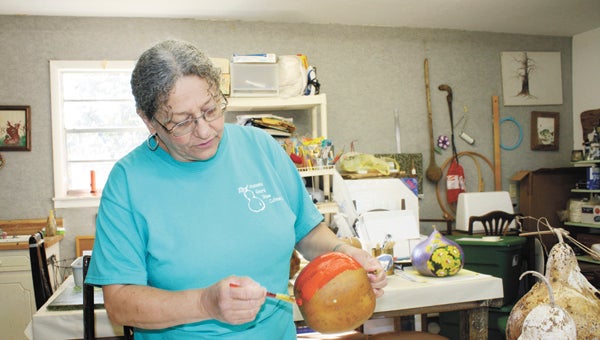Locals demonstrate dynamics of gourd art
Published 12:01 am Saturday, February 19, 2011
The art of gourd making will take center stage Sunday in Opp at the first ever Heart of Dixie Gourd Patch show and competition.
Patch president Anita Ellis said there is only one other gourd show in the state in Cullman.
The local show will be held tomorrow from 2 p.m. until 5 p.m. at Anita’s Home Gallery on Ellis Road.
Members of the patch and gourd artists from around South Alabama will showcase their gourd art creations, as well as creations by award-winning artist, Terri Camp.
But exactly how does one make gourd art?
Ellis said that a gourd must cure for an entire year before it can be used for gourd art, and then, it must be cleaned inside and out.
“The first step is to soak your gourd in a tub of water with bleach and Greased Lightning,” said Camp. “You also need a copper scrubber to help get off the outer layer of skin.”
Camp said that once all the excess skin is removed, one would be surprised at what the gourd looks like underneath.
“There are beautiful patterns,” she said. “In fact, sometimes people do very little painting and just varnish them.”
Perhaps the most tedious part of the whole job is getting the “gourd silk” out of the inside of the gourd, she said.
“It’s hard to get out unless you soak it,” Camp said. “There are about 150 different ways to clean the inside out. I use a gourd attachment to clean mine out.”
Camp said others use spoons, seashells or small sanders.
“The gourd has to be cleaned out really good,” she said. “If you enter shows, the judges will check for that. A gourd can be graded down depending on how you treat the rough patches.”
Once all of the silk has been removed, it’s time to decide if the gourd will be cut or not.
“The best way to do it is put something to trace on top of the gourd or where you want to cut and move the gourd around to draw the pattern,” Camp said. “I used a hack saw to cut mine.”
Ellis said she uses a jigsaw, but all one really needs is a fine-tooth blade of some kind.
“They make mini saws or gourd saws that have a very fine blade,” Ellis said. “Really it’s just a mini jigsaw.”
Camp said a mini saw is needed to cut intricate designs in the small spaces of a gourd.
For those who want to do more than just “decorate” a gourd, the possibilities are endless.
Renowned artists make anything from bowls to drums and other 3D pieces, which sometimes requires putting two or more gourds together.
“The trick is to finish all the edges with sand paper,” she said. “Watch how you finish everything. The best thing to use is air-dried clay to keep the gourds together.”
Camp said that sometimes “you need six arms to finish a piece.”
“Sometimes it won’t stay together unless you use hot glue or prop something against it,” she said. “It’s quite a daunting task. It takes a long time to get everything where you want.”
For those who want to paint their gourds, both Ellis and Camp said there are many options.
“You can use acrylic, oil pastels, Kool Aid, leather dyes, ink, watercolor, oil, shoe polish, house paint, really anything,” Ellis said. “You can even use paint and sand to fill in areas and give it a more textured look.”
Ellis said she likes to use acrylics because of its quick drying ability.
“Once you go around once with acrylic, it will be dry and ready to go again,” she said. “You can also use a blow dryer, if you’d like.”
Finally, once the gourd is complete, Ellis said there are about 100 different types of finishes.
“Satin, matte and gloss are some of the most popular,” she said. “It really depends on the effect you want.”
Camp said that every gourd needs some type of finish for protection.
For those interested in learning gourd techniques, Ellis said the Patch meets every third Saturday at 3 p.m. at Anita’s Home Gallery.
For more information, call Ellis at 493-7166 or Camp at 493-9871.






